"A tree is a wonderful living organism which gives shelter, food,
warmth and protection to all living things. It even gives shade to
those who wield an axe to cut it down" - Buddha.
There are probably hundreds of majestic and magnificent trees in the world - of these, some are particularly special:
10. Lone Cypress in Monterey
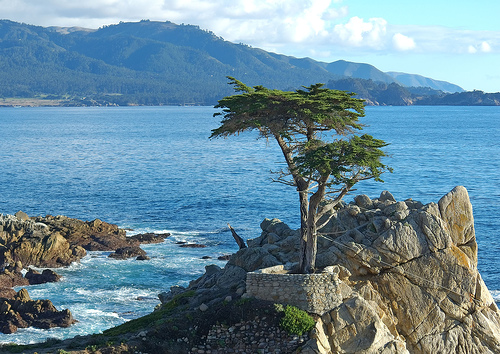
(Image credit: bdinphoenix [flickr])
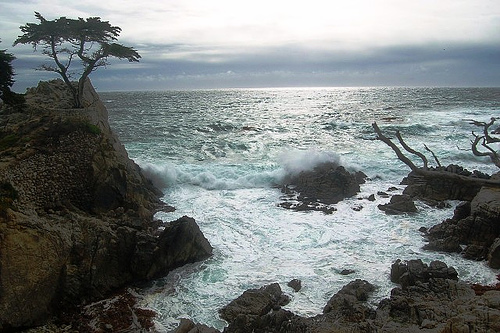
(Image credit: mikemac29 [flickr])
Buffeted by the cold Pacific Ocean wind, the scraggly Lone Cypress [wiki] (Cupressus macrocarpa) in Pebble Beach, Monterey Peninsula, California, isn't a particularly large tree. It makes up for its small size, however, with its iconic status as a stunningly beautiful tree in splendid isolation, framed by an even more beautiful background of the Pacific Ocean.
9. Circus Trees
As a hobby, bean farmer Axel Erlandson [wiki] shaped trees - he pruned, bent, and grafted trees into fantastic shapes and called them "Circus Trees." For example, to make this "Basket Tree" arborsculpture, Erlandson planted six sycamore trees in a circle and then grafted them together to form the diamond patterns.
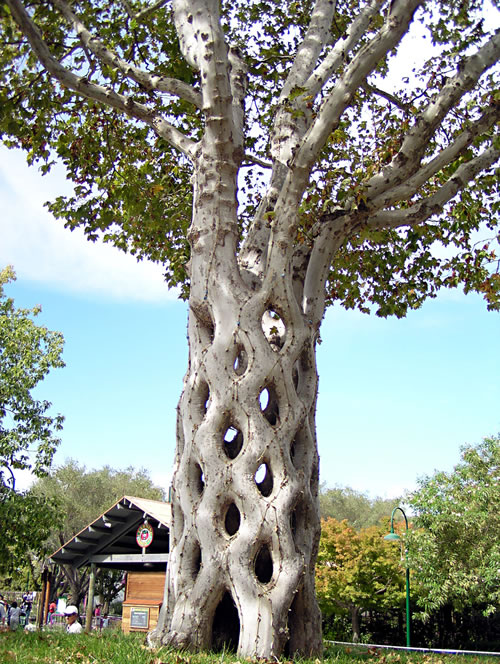
Basket Tree (Image credit: jpeepz [flickr])
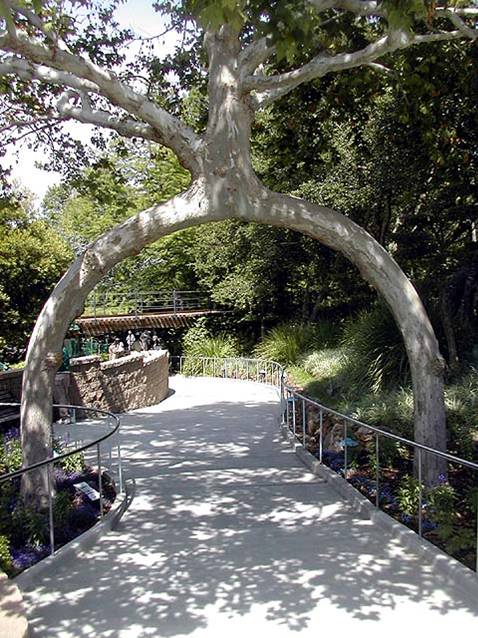
The two-legged tree (Image credit: Vladi22, Wikipedia)
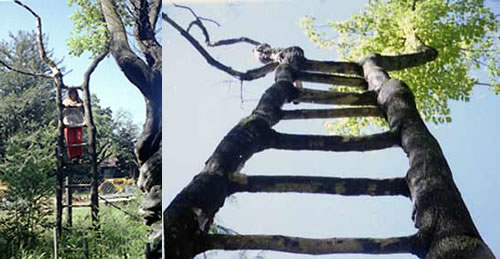
Ladder tree (Image credit: Arborsmith)
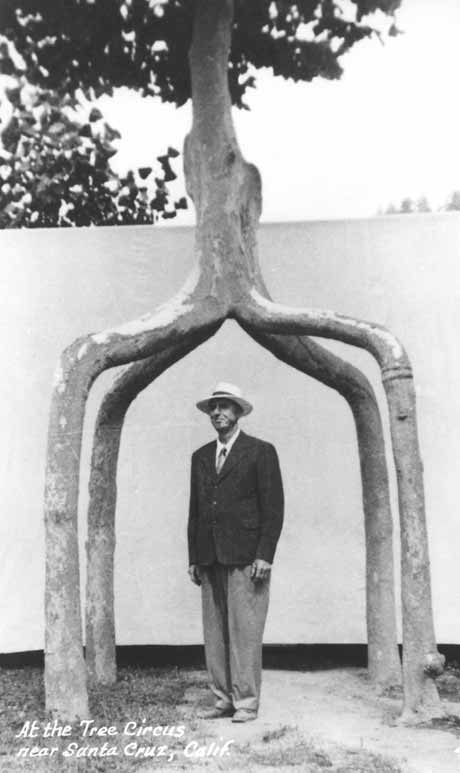
Axel Erlandson underneath one of his arborsculpture (Image credit: Wilma Erlandson, Cabinet Magazine)
Erlandson was very secretive and refused to reveal his methods on how to grow the Circus Trees (he even carried out his graftings behind screens to protect against spies!) and carried the secrets to his grave.
The trees were later bought by millionaire Michael Bonfante, who transplanted them to his amusement park Bonfante Gardens in Gilroy in 1985.
8. Giant Sequoias: General Sherman
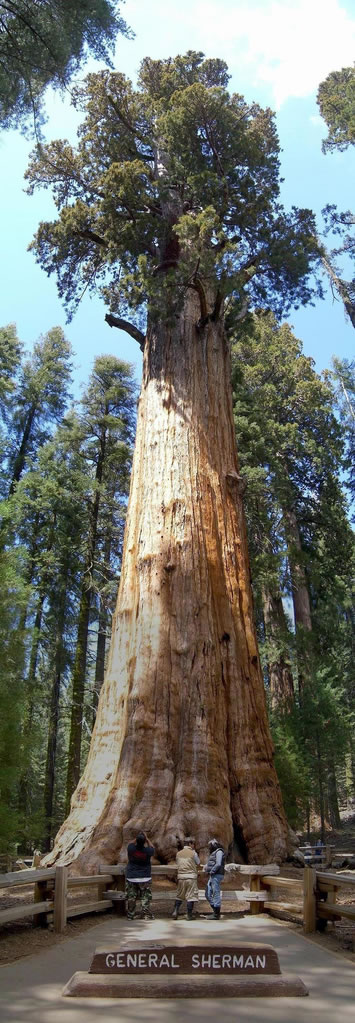
(Image credit: Humpalumpa [flickr])
Giant Sequoias [wiki] (Sequoiadendron giganteum), which only grow in Sierra Nevada, California, are the world's biggest trees (in terms of volume). The biggest is General Sherman [wiki] in the Sequoia National Park - one behemoth of a tree at 275 feet (83.8 m), over 52,500 cubic feet of volume (1,486 m³), and over 6000 tons in weight.
General Sherman is approximately 2,200 years old - and each year, the tree adds enough wood to make a regular 60-foot tall tree. It's no wonder that naturalist John Muir said "The Big Tree is Nature's forest masterpiece, and so far as I know, the greatest of living things."
For over a century there was a fierce competition for the title of the largest tree: besides General Sherman, there is General Grant [wiki] at King's Canyon National Park, which actually has a larger circumference (107.5 feet / 32.77 m vs. Sherman's 102.6 feet / 31.27 m).
In 1921, a team of surveyors carefully measured the two giants - with their data, and according to the complex American Forestry Association system of judging a tree, General Grant should have been award the title of largest tree - however, to simplify the matter, it was later determined that in this case, volume, not point system, should be the determining factor.
7. Coast Redwood: Hyperion and Drive-Thru Trees
 There is another sequoia species (not to be confused with Giant Sequoia) that is quite remarkable: the Coast Redwood [wiki] (Sequoia sempervirens), the tallest trees in the world.
There is another sequoia species (not to be confused with Giant Sequoia) that is quite remarkable: the Coast Redwood [wiki] (Sequoia sempervirens), the tallest trees in the world.
The reigning champion is a tree called Hyperion in the Redwood National Park, identified by researcher Chris Atkins and amateur naturalist Michael Taylor in 2006. Measuring over 379 feet (155.6 115 m) tall, Hyperion beat out the previous record holder Stratosphere Giant [wiki] in the Humboldt Redwoods State Park (at 370 feet / 112.8 m).
The scientists aren't talking about the exact location of Hyperion: the terrain is difficult, and they don't want a rush of visitors to come and trample the tree's root system.
[Image: The Stratosphere Giant - still an impressive specimen, previously the world's tallest tree until dethroned by Hyperion in 2006.]
That's not all that's amazing about the Coast Redwood: there are four giant California redwoods big enough that you can drive your car through them!
The most famous of the drive-through trees is the Chandelier Tree [wiki] in Leggett, California. It's a 315 foot tall redwood tree, with a 6 foot wide by 9 foot tall hole cut through its base in the 1930s.
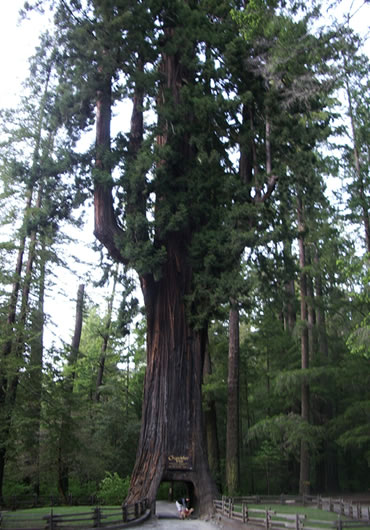
Chandelier Tree. (Image credit: hlh-abg [flickr])
6. Chapel-Oak of Allouville-Bellefosse
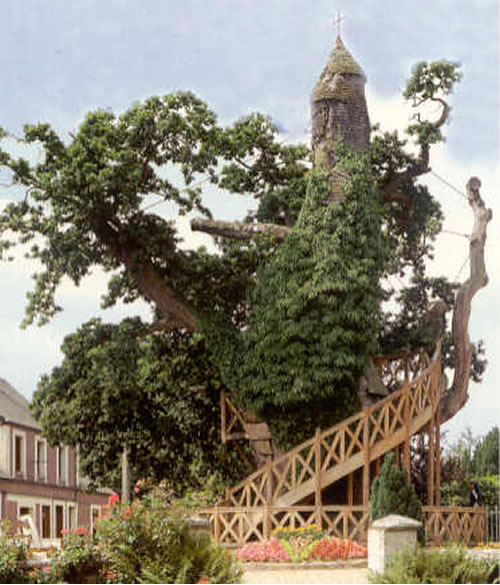
Chapel-Oak of Allouville-Bellefosse (Image credit: Old trees in Netherlands & Europe)
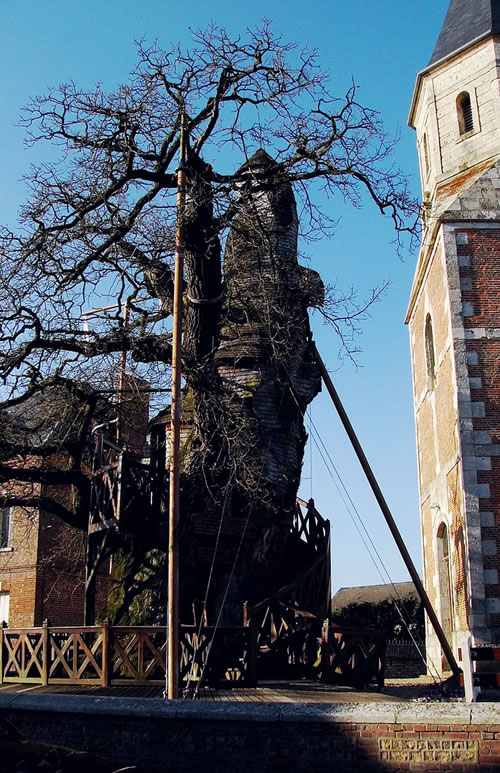
(Image credit: dm1795 [flickr])
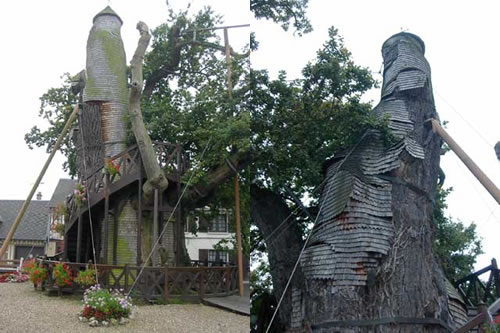
(Image credit: Luc Doudet)
The Chêne-Chapelle (Chapel-Oak) of Allouville-Bellefosse is the most famous tree in France - actually, it's more than just a tree: it's a building and a religious monument all in one.
In 1669, l'Abbe du Detroit and du Cerceau decided to build a chapel in (at that time) a 500 years old or so oak (Quercus robur) tree made hollow by a lightning bolt. The priests built a small altar to the Virgin Mary. Later on, a second chapel and a staircase were added.
Now, parts of the tree are dead, the crown keeps becoming smaller and smaller every year, and parts of the tree's bark, which fell off due to old age, are covered by protective oak shingles. Poles and cables support the aging tree, which in fact, may not live much longer. As a symbol, however, it seems that the Chapel-Oak of Allouville-Bellefosse may live on forever.
5. Quaking Aspen: Pando (The Trembling Giant)
Quaking Aspen (Image: Wikipedia)
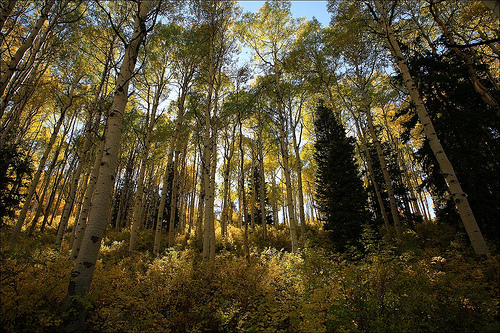
Aspen grove (Image credit: scottks1 [flickr])

Quaking Aspen in winter (Image credit: darkmatter [flickr])
Pando [wiki] or the Trembling Giant in Utah is actually a colony of a single Quaking Aspen (Populus tremuloides) tree. All of the trees (technically, "stems") in this colony are genetically identical (meaning, they're exact clones of one another). In fact, they are all a part of a single living organism with an enormous underground root system.
Pando, which is Latin for "I Spread," is composed of about 47,000 stems spread throughout 107 acres of land. It estimated to weigh 6,600 tons, making it the heaviest known organism. Although the average age of the individual stems are 130 years, the entire organism is estimated to be about 80,000 years old!
4. Montezuma Cypress: The Tule Tree
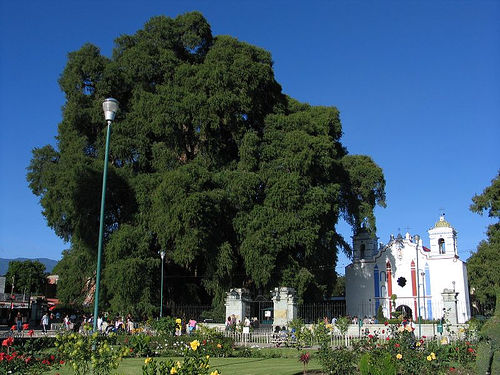
The Tule Tree Towers over a church next to it (Image credit: jubilohaku [flickr])
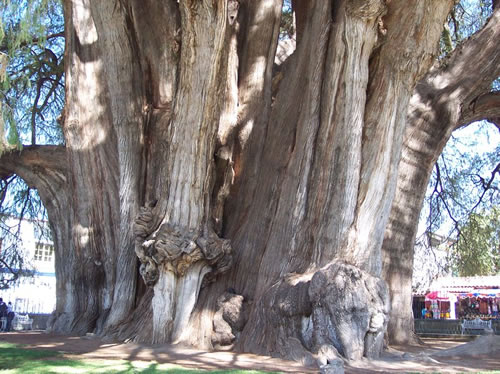
Full width of the Tule Tree (Image credit: Gengiskanhg, Wikipedia)
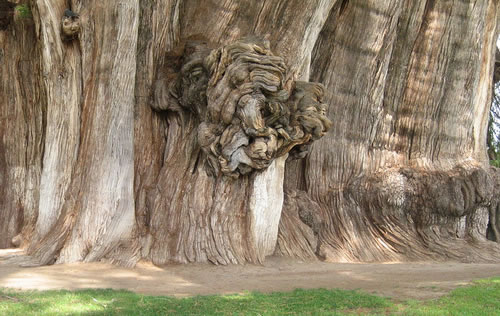
Close-up of the tree's gnarled trunk. Local legends say that you can make out animals like jaguars and elephants in the trunk, giving the tree the nickname of "the Tree of Life" (Image credit: jvcluis [flickr])
El Árbol del Tule [wiki] ("The Tule Tree") is an especially large Montezuma cypress (Taxodium mucronatum) near the city of Oaxaca, Mexico. This tree has the largest trunk girth at 190 feet (58 m) and trunk diameter at 37 feet (11.3 m). The Tule tree is so thick that people say you don't hug this tree, it hugs you instead!
For a while, detractors argued that it was actually three trees masquerading as one - however, careful DNA analysis confirmed that it is indeed one magnificent tree.
In 1994, the tree (and Mexican pride) were in jeopardy: the leaves were sickly yellow and there were dead branches everywhere- the tree appeared to be dying. When tree "doctors" were called in, they diagnosed the problem as dying of thirst. The prescription? Give it water. Sure enough, the tree soon recovered after a careful watering program was followed.
3. Banyan Tree: Sri Maha Bodhi Tree
The Banyan tree is named after "banians" or Hindu traders who carry out their business under the tree. Even if you have never heard of a Banyan tree (it was the tree used by Robinson Crusoe for his treehouse), you'd still recognize it. The shape of the giant tree is unmistakable: it has a majestic canopy with aerial roots running from the branches to the ground.
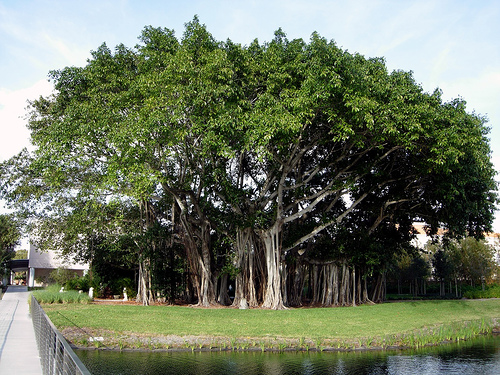
Banyan tree (Image credit: Diorama Sky [flickr])
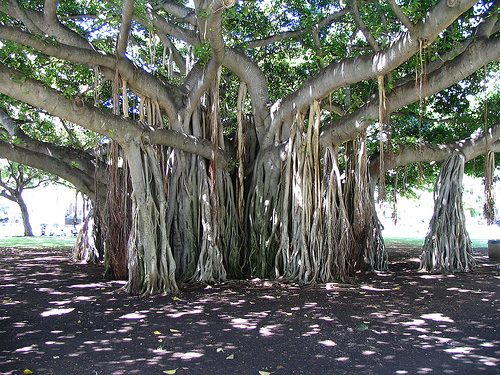
Closer view of the Banyan aerial root structure (Image credit: BillyCrafton [flickr])
If you were thinking that the Banyan tree looks like the trees whose roots snake through the ruins of the Ta Prohm temple like tentacles of the jungle (Lara Croft, anyone?) at Ankor, Cambodia , you'd be right!
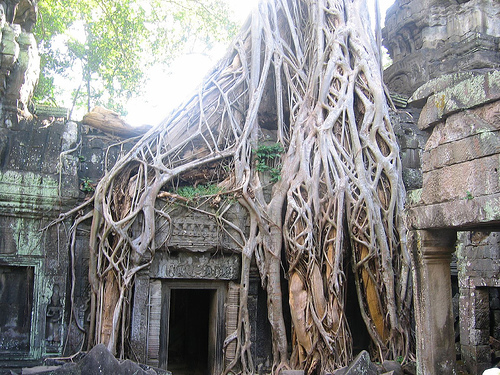
Banyan tree (or is it silk-cotton tree?) in the ruins of Ta Prohm, Ankor, Cambodia
(Image Credit: Casual Chin [flickr])
One of the most famous species of Banyan, called the Sacred Fig [wiki] or Bo tree, is the Sri Maha Bodhi [wiki] tree in Anuradhapura, Sri Lanka. It is said that the tree was grown from a cutting from the original tree under which Buddha became enlightened in the 6th century BC.
Planted in 288 BC, it is the oldest living human-planted tree in the world, with a definitive planting date!
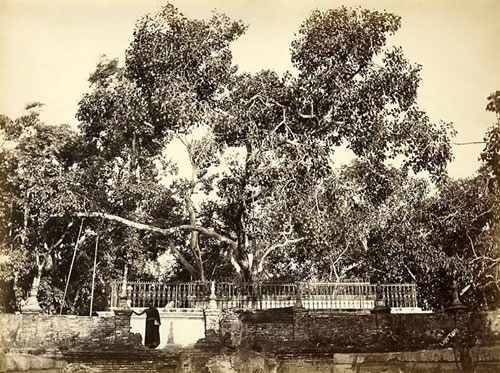
(Image credit: Images of Ceylon)
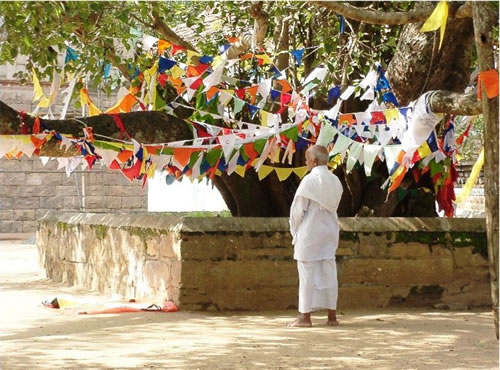
(Image credit: Wikipedia)
2. Bristlecone Pine: Methuselah and Prometheus, the Oldest Trees in the World.
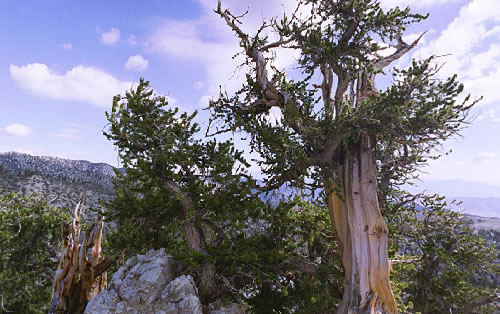
Methuselah Grove (Image Credit: NOVA Online)
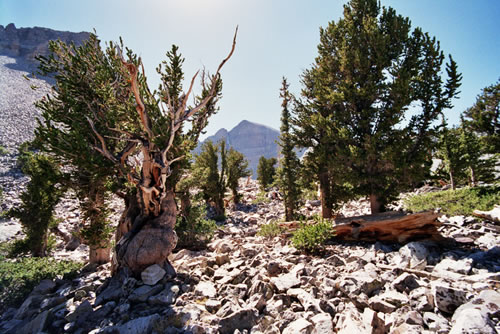
Bristlecone pine grove in which Prometheus grew (Image credit: James R. Bouldin, Wikipedia)
The oldest living tree in the world is a White Mountains, California, bristlecone pine (Pinus longaeva) named Methuselah [wiki], after the Biblical figure who lived to 969 years old. The Methuselah tree, found at 11,000 feet above sea level, is 4,838 years old - it is not only the oldest tree but also the oldest living non-clonal organism in the world.
Before Methuselah was identified as the world's oldest tree by Edmund Schulman in 1957, people thought that the Giant Sequoias were the world's oldest trees at about 2,000 years old. Schulman used a borer to obtain a core sample to count the growth rings of various bristlecone pines, and found over a dozen trees over 4,000 years old.
The story of Prometheus [wiki] is even more interesting: in 1964, Donald R. Currey [wiki], then a graduate student, was taking core samples from a tree named Prometheus. His boring tool broke inside the tree, so he asked for permission from the US Forest Service to cut it down and examine the full cross section of the wood. Surprisingly the Forest Service agreed! When they examined the tree, Prometheus turned out to be about 5,000 years old, which would have made it the world's oldest tree when the scientist unwittingly killed it!
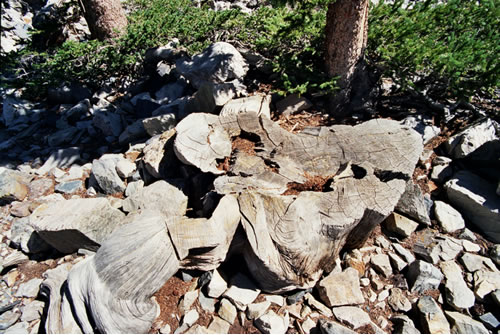
Stump of the Prometheus Tree. (Image Credit: James R. Bouldin, Wikipedia)
Today, to protect the trees from the inquisitive traveler, the authorities are keeping their location secret (indeed, there are no photos identifying Methuselah for fear of vandalism).
1. Baobab
The amazing baobab [wiki] (Adansonia) or monkey bread tree can grow up to nearly 100 feet (30 m) tall and 35 feet (11 m) wide. Their defining characteristic: their swollen trunk are actually water storage - the baobab tree can store as much as 31,700 gallon (120,000 l) of water to endure harsh drought conditions.
Baobab trees are native to Madagascar (it's the country's national tree!), mainland Africa, and Australia. A cluster of "the grandest of all" baobab trees (Adansonia grandidieri) can be found in the Baobab Avenue, near Morondava, in Madagascar:
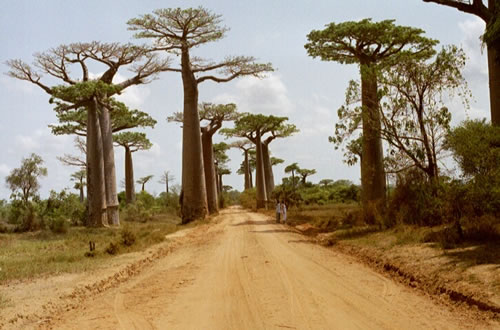
(Image credit: Fox-Talbot, Wikipedia)

(Image credit: plizzba [flickr])
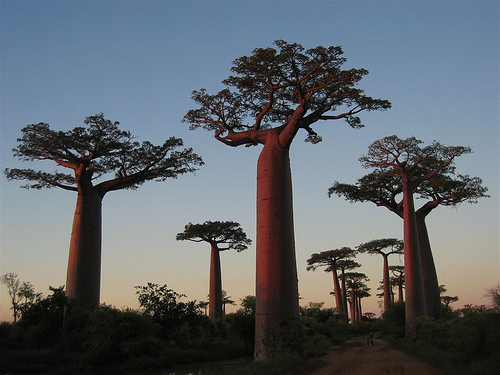
(Image credit: Daniel Montesino [flickr])
In Ifaty, southwestern Madagascar, other baobabs take the form of bottles, skulls, and even teapots:
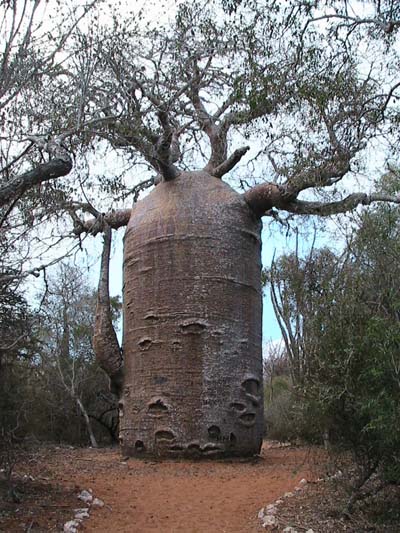
Teapot baobab (Image credit: Gilles Croissant)
The baobab trees in Africa are amazing as well:
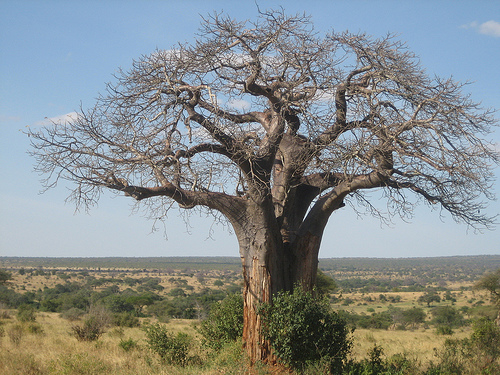
Baobab in Tanzania (Image credit: telethon [flickr])
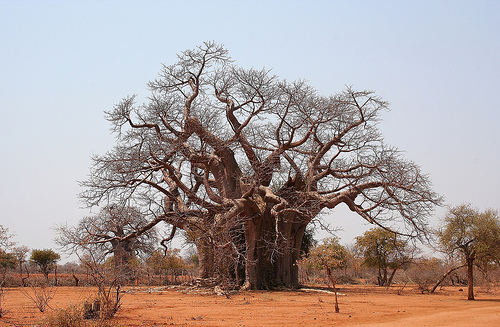
Baobab near Bulawayo, Zimbabwe (Image credit: ironmanix [flickr])
There are many practical uses of baobab trees, like for a toilet:
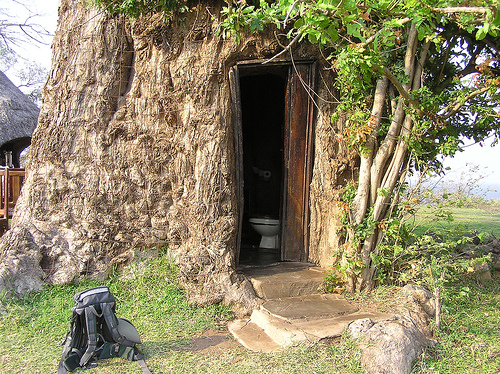
A toilet built inside a baobab tree in the Kayila Lodge, Zambia
(Image credit: Steve Makin [flickr])
... and even for a prison:
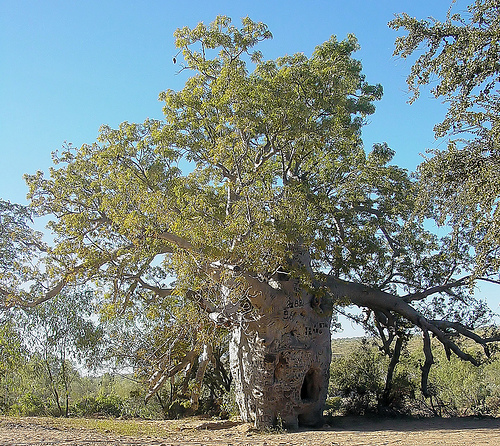
A "Prison Baob" tree in Western Australia (Image credit: yewenyi [flickr])
Bonus: Tree That Owns Itself
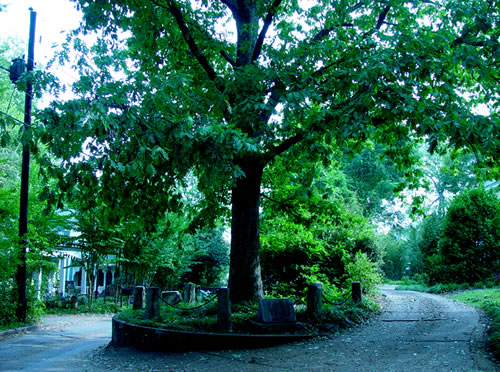
Son of the Tree That Owns Itself (Image Credit: Bloodofox, Wikipedia)
Legend has it that the Tree That Owns Itself [wiki], a white oak in Athens, Georgia was given ownership of itself and the surrounding land by Dr. William Henry Jackson in 1820! The original tree had died long ago, but a new tree (Son of The Tree That Owns Itself) was planted at the same location from one of its acorns.
Bonus 2: The Lonely Tree of Ténéré
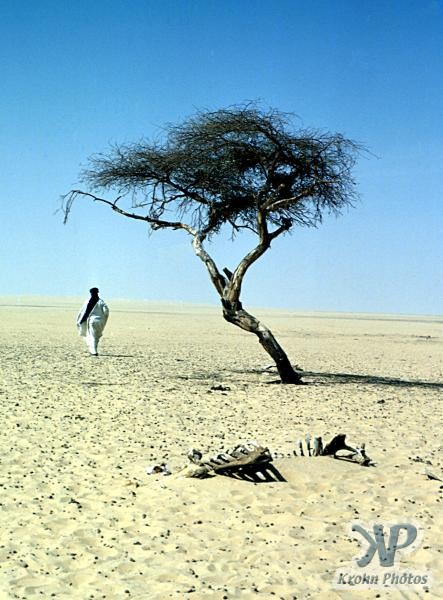
The Tree of Ténéré in the 1970s, before a truck crashed into it (Image credit: Peter Krohn)
The Tree of Ténéré or L'Abre du Ténéré was the world's most isolated tree - the solitary acacia, which grew in the Sahara desert in Niger, Africa, was the only tree within more than 250 miles (400 km) around.
The tree was the last surviving member of a group of acacias that grew when the desert wasn't as dry. When scientists dug a hole near the tree, they found its roots went down as deep as 120 feet (36 m) below to the water table!
Apparently, being the only tree in that part of the wide-open desert (remember: there wasn't another tree for 250 miles around), wasn't enough to stop a drunk Libyan truck driver from driving his truck into it, knocking it down and killing it!
Now, a metal sculpture was placed in its spot to commemorate the Lonely Tree of Ténéré:

(Image credit: Nomad's Land, main website)
I'll be the first to acknowledge that this list is far from complete: there are many more magnificent trees in the world (for instance, see the List of Famous Trees [wiki]). If you have any addition of noteworthy tree (and stories about trees), please leave it in the comment section.

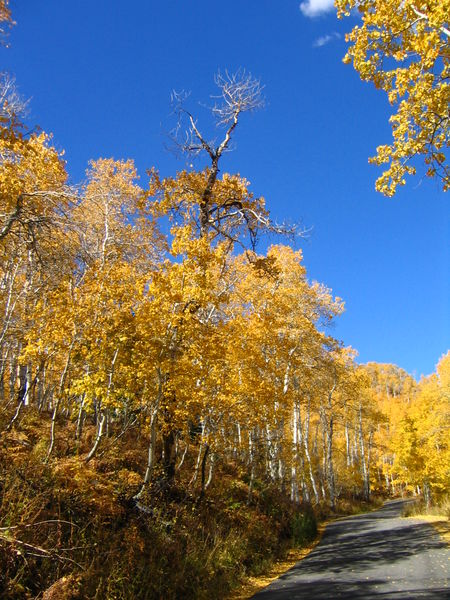





What about the Queen Elizabeth Oak for great trees? http://www.gravelroots.net/mapage5.html
I live near a 500+ year old European Ash which has a very wide girth, really wide at the bottom where its roots go into the ground. Also live near 8 huge Scots Pine trees (100ft+ with a very wide top) which I have called the area the giant pine road due to the pines growing on the side of a road beside some fields.
You have to wonder how anyone managed to drive into the Arbre du Ténéré...
Merci